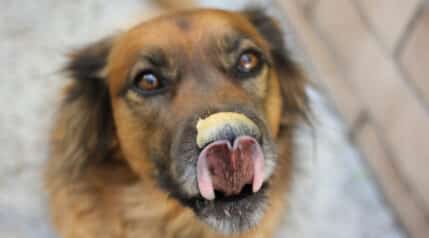Jelly beans are a sweet treat intended for humans, not your dog. They are full of sugar, artificial flavors, colorings, and possibly other toxic ingredients such as xylitol or caffeine. Some of these ingredients can be harmful or even fatal for our canine companions.
Even if you did not intend to give your dog jelly beans, it could be easy to drop one on the floor, and before you know it, it’s been devoured. So, can dogs eat them? Are they safe or harmful?
Although your dog should not eat jelly beans, some varieties are safer than others. If you are not sure what type your pup just consumed, call your veterinarian for advice, even if they appear well. Let’s look at what you can expect and your next steps.
Are Jelly Beans Safe for Dogs?

Although it is not recommended to feed jelly beans to your dog, accidents can happen. If your pup has eaten them, you will need to check the ingredients to know whether they are safe. Whether they become ill can also depend on how many they have eaten.
Some types may only cause a mild tummy upset, but it’s best to play it safe and call your veterinarian. If you read them the ingredients list, they can tell you if what was consumed is safe. Do this even if your pup looks well, as symptoms can take time to develop, and it is best not to “wait and see.“
Why Are They Bad for Dogs?
Jelly beans are a bad choice as a treat. They do not provide any nutritional value, and feeding them to your pup can cause them serious harm if certain ingredients are included.
They can also be particularly harmful if your dog has any other illness, such as diabetes, a heart condition, liver disease, skin allergies, gut problems, or obesity. Puppies and older dogs find it more challenging to overcome illness, so they are at greater risk of developing more serious complications as a consequence of consuming them.
The danger they can pose depends on their ingredients, which can vary. While some ingredients pose little threat, others may cause a bigger problem. The ingredients which are the biggest threat to canine health are as follows:
- xylitol
- caffeine
- pectin or starch
- sugar
- flavorings
Xylitol

A common artificial sweetener, Xylitol, is often used in sugar-free candy. It can be found in jelly beans and other products such as gum, peanut butter, jelly, and candy sold as sugar-free. It is also found in some toothpaste and mouthwash.
It’s important to be aware that ingredients called “birch sugar” or “birch sap” are derived from the same toxic plant as Xylitol, so you need to be vigilant in reading ingredient lists.
Xylitol and its likenesses can be deadly if Fido eats sweet treats that contain it. It causes a sudden drop in blood sugar to dangerously low levels, called ‘hypoglycemia’. Usually, this happens within 30 minutes of eating food containing xylitol, but it can depend on how quickly the candy has been digested.
In some dogs, it can take up to 18 hours after consuming xylitol before developing symptoms. Do not wait around for signs of toxicity if you know they have eaten anything containing xylitol. Call your veterinarian right away.
The signs of hypoglycemia from xylitol toxicity are:
- drowsiness
- vomiting
- excessive drooling
- staggering
- loss of consciousness or slow to respond
- seizures
- coma
Xylitol consumption can also cause liver failure in some dogs. Unfortunately, xylitol toxicity can result in death if not treated quickly enough. This is why you must contact your veterinarian as soon as possible if xylitol was consumed in any fashion. If Fido shows any of the symptoms listed above, and you don’t know if they have eaten xylitol, call your veterinarian for advice.
I spoke to veterinarian Lizzie Youens about the dangers of xylitol.
“As sugar free food options are becoming increasingly popular, I am seeing more cases of xylitol toxicity in dogs in the veterinary clinic – it can be a real hidden threat. Also known as birch sugar or wood sugar, xylitol is found in many sugar-free sweets, including some jelly beans. It can make dogs really ill, so always check packaging carefully if your dog has managed to eat something naughty!”
Veterinarian Lizzie Youens
Caffeine

Caffeine can be found in coffee, chocolate, tea (green and black), carbonated drinks, energy drinks, and even some medicines. Caffeine is also added as a stimulant to some energy candies. It comes from the same compound as theobromine, which is the chemical toxin that causes chocolate toxicity in dogs.
The effects caffeine has on your dog are more severe than those it has on humans. If even a small amount of caffeine was consumed, signs of toxicity may occur. After eating, caffeine is absorbed in your dog’s gut within 45 minutes, and symptoms are often seen after two hours. So it is essential to get your pup seen by a veterinarian as soon as possible.
The signs of caffeine toxicity are:
- restlessness
- high body temperature (hyperthermia)
- fast heartbeat
- seizures
- shaking
- abnormal reaction to touch or movement around them
Unfortunately, like xylitol, caffeine toxicity can result in death.
Caffeine and xylitol poisoning are veterinary emergencies. You must call your veterinarian as soon as you suspect anything was consumed that contains either xylitol or caffeine. This gives them the best chance of survival.
Sugar

Like most candies, they contain added sugar to give them their sweet taste. Dogs can find this irresistible, but too much sugar can cause problems.
If your dog eats large amounts of sugar or candy in one go, it may vomit or have diarrhea. If Fido gets lots of sugary treats too often, they will gain weight. Overweight dogs are more likely to develop diabetes and heart disease. The extra weight also puts pressure on their bones and joints, so they are more likely to develop painful arthritis. Sugar is also bad for their teeth and gums.
Healthier treats that contain no sugar or natural sugars are a safer alternative. Your veterinarian will be able to advise you on the best treats to give your pup.
Pectin or Starch

Most jelly beans have added starch to give them their jelly-like consistency. Pectin is a type of starch found in some candies. It can also be found in some veterinary products to treat diarrhea. While pectin isn’t toxic, it may give your dog gut problems such as constipation if eaten in large quantities.
Flavorings

Jelly beans come in a mass of flavors. Most are artificial and may upset your dog’s stomach if too many are eaten. Some types may contain traces of ingredients, such as chocolate (cocoa) or grape, that are not safe for Fido to eat.
It is not easy to determine the exact quantity of flavorings within these products and whether they will cause harm. However, it is another good reason to avoid feeding them to your dog or to call your veterinary clinic if they have eaten any.
What Will My Veterinarian Do?

Your veterinarian will want to know precisely what candy was eaten. It is a good idea to take along the candy wrapper when you take your pup to the clinic, so the veterinarian can examine the ingredients. They may also want to call poison control to help decide as to how toxic they are.
Your veterinarian might want to make your dog vomit to get rid of the harmful toxins before they are absorbed in their gut. They can do this by giving an injection. Usually, this is the treatment if the candy has only just been eaten or if there are no signs of toxicity.
Do not make your pup vomit at home unless asked to do so by a veterinarian. Many of the recipes for how to make a dog vomit at home are dangerous and can put Fido at greater risk. Your vet is the best person to weigh up the risks and decide which route of action to take.
If your dog is sick, they may need to stay at the veterinary clinic for additional treatment or observation overnight. The sooner you can get to the clinic for treatment, the less chance the toxins have of absorbing into your dog’s body.
Frequently Asked Questions
My dog ate jelly beans, what should I do?
If you still have the packet check the ingredients and keep hold of it in case you need to take your dog to a veterinarian. If they are made with xylitol or caffeine, call your veterinary clinic right away, even if Fido seems fine. If they do not contain xylitol or caffeine, you can monitor your pup, but be prepared to call your veterinary clinic for advice if you notice more serious symptoms.
What should I do if my dog ate xylitol?
Call your veterinary clinic urgently, even if they have eaten only a small amount or are not unwell. Xylitol toxicity causes a canine’s blood sugar to drop dangerously low and can cause death. Your dog will need to be examined by a veterinarian who will give them the right treatment.
What are the symptoms of xylitol poisoning?
Xylitol poisoning can cause hypoglycemia which is a dangerously low drop in blood sugar. The symptoms are vomiting, drowsiness, staggering, loss of consciousness, seizures, coma, and finally can cause death. If your pup does not have any symptoms, you must still call your veterinarian urgently if you think they have eaten anything containing xylitol.
Can one jelly bean kill a dog?
Some jelly beans contain ingredients like xylitol or caffeine, which can cause death in dogs, even if eaten in minimal amounts. It’s best to avoid giving any human candies to your dog and choose healthier alternatives. If your pup has eaten any candy, you should call your veterinarian for advice.
Final Thoughts
No, it is not a good idea to deliberately feed your dog jelly beans. If your pup has accidentally eaten them, check the ingredients to see if they contain xylitol or caffeine. These are toxic to canines and can cause death if eaten. Call your veterinarian urgently if Fido has eaten anything containing xylitol or caffeine.
Even jelly beans without xylitol or caffeine often have high sugar and starch content and can cause stomach upset. Given long-term, they could gain weight, and develop diabetes, heart disease, and dental disease. Most candy is not a suitable treat for dogs. If you want to give your dog a treat, ask your veterinarian for healthy alternatives.





